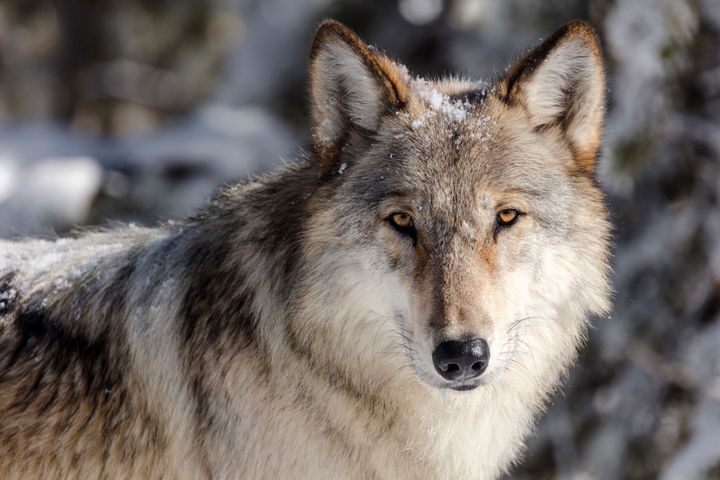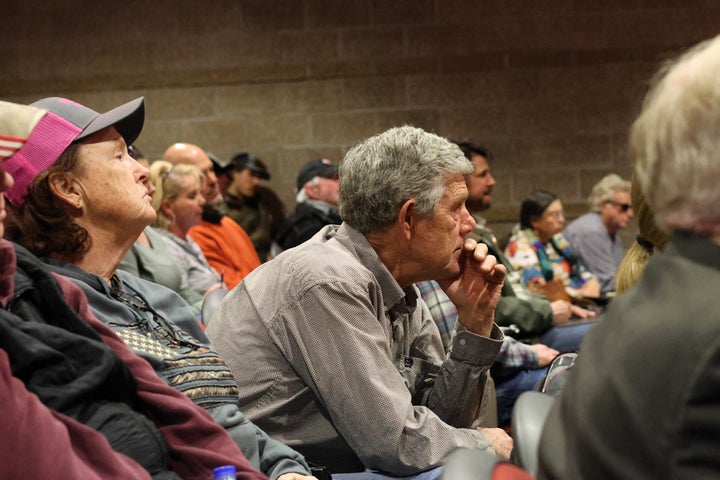RIFLE, Colo. ― When Lenny Klinglesmith, a rancher from Meeker in northwest Colorado, took the microphone at a public wildlife commission meeting here this month, he endorsed the state’s draft plan to reintroduce wolves.
Then, he laid out a doomsday vision.
Since Colorado voters passed a referendum in 2020 to reintroduce wolves to the state’s rural Western Slope, opponents have feared that the restored predators will decimate elk herds and eat into profits from ranching ― a difficult business in the best of times.

In the scenario Klinglesmith laid out at the meeting, each wolf would eat around 20 elk per year. Some of those elk would die from harsh winters or scarce forage regardless, so Klinglesmith guesstimated that wildlife officials might factor about 85% of those wolf kills into their calculations when issuing hunting permits.
That back-of-the-napkin math translates to 1,700 fewer elk for hunters for every 100 wolves in the state. Since fewer than 1 in 5 hunters who buy an elk permit actually kill one in any given year, the state might have to cut back tags by about 10,500 for each 100 wolves.
By the time Colorado reaches 1,000 wolves, a milestone that Klinglesmith expects to reach in a little more than a decade, lost revenue from a plunge in elk license sales could top $30 million.
“It could be severe,” Klinglesmith said. “This plan is going to fall on the next generation.”
Klinglesmith’s conclusions could easily prove incorrect. High mortality is a fact of life for prey species like elk that evolved as food for predators like wolves. A lot of them, especially males and calves, can die without cratering the population as a whole.
“Wolves regulate themselves at some level,” said Gary Skiba, wildlife manager for the San Juan Citizens Alliance, a group that backed the 2020 wolf referendum. “These predictions of disaster are a worst-case scenario that has never happened anywhere else.”
Still, fears like Klinglesmith’s have dogged wolf reintroduction since the federal government launched a recovery program for the Endangered Species Act-protected animals at Yellowstone National Park and in central Idaho in the mid-1990s.
The main method that Republican-dominated states of the northern Rockies have used to calm those concerns is lethal control. Idaho, Montana and Wyoming wrested wolf management from the U.S. Fish and Wildlife Service as soon as possible to implement hunting and trapping seasons and make it easier for farmers and ranchers to kill wolves that threaten livestock ― policies that have led to more than two decades of court battles with pro-wolf environmental and animal rights groups.
But in Colorado, for the first time, a state led by Democrats will start releasing wolves with no plans to rely heavily on lethal control ― a hands-off policy that will turn the state into a testing ground to prove whether fears of elk and cattle decimation are well founded, or whether wolf advocates have been right all along to dismiss them.
Colorado voters passed a referendum in 2020 by a margin of just under 2 percentage points mandating the reintroduction of wolves on the Western Slope of the continental divide. Urbanites generally favored the measure, while rural Coloradans largely opposed it.
Since then, state wildlife officials have scrambled to build a plan that complies with state law, assuages rural Coloradans’ concerns, and dovetails with federal law. The state plans to release its first wolves this December.
“Nobody is going to get exactly what they want,” acting Colorado Parks and Wildlife Director Heather Dugan told the crowd at the Rifle meeting. “We’re hoping to get a plan we can live with.”
No one doubts wolves will thrive here. With public land accounting for 43% of Colorado, including 3.7 million acres of federal wilderness, wolves will have ample room to roam. And with the country’s largest elk herd, the canine apex predators will have plenty to eat.
The question now looming over those who will have to live and work alongside the restored predators is how much it’s going to cost them.
Shouldering The Costs
Ranchers and hunting outfitters packed an auditorium at Colorado Mountain College in Rifle, a small town in northwest Colorado, to air their grievances. One referred to wolves as “Satan.” A young woman who had recently moved here from Fairbanks, Alaska, worried that locals wouldn’t know how to deal with predators with a pack mentality.
Virtually all of them appeared to think that supporters had vastly underestimated costs to ranchers, the hunting industry and the state’s own parks and wildlife division.

The biggest and most organized industry that wolves will affect is ranching, a major enterprise across the state’s western half, where cattle and sheep graze on both private and public ground. The draft plan commits the state to pay fair-market value for livestock, working dogs and horses killed by wolves, with a yet-to-be-finalized cap that the Colorado Parks and Wildlife Commission has currently slated at $15,000 per head.
Those costs could stack up quickly in a state that plans to manage wolves with a light hand. If the wolf population were to reach 1,000 wolves, compensation costs could run up to $100,000 in a single night, according to Ken Spann, a member of the Gunnison County Stockgrowers’ Association.
“These costs were mandated by the people of the state of Colorado, and they should be paid for by the people of Colorado,” Spann said at the meeting.
The added labor cost of guarding livestock from wolves also threatens to eat into ranchers’ bottom lines. “Spending all night in the snow protecting calving cows ― that’s a real cost,” Spann said.
Hunting outfitters are far more exposed. Wolves don’t have to attack elk to upend their businesses. A rumor that wolves have made their way into a permitted hunting area is enough to scare off clients.
The draft plan doesn’t compensate outfitters for business losses, even though hunting is a major part of rural Colorado’s economy, propping up an off-season tourism industry catering to moneyed out-of-staters. Many ranchers run hunting outfits on the side to add a second income stream to a tough business.
“The wolves coming to Colorado are really falling on our backs to pay for,” outfitter Curtis Ellgen told the crowd at the Rifle meeting. “Are you willing to give up your livelihood to make this happen? Or just mine and those of people like me?”
Colorado Parks and Wildlife will also need to hire more damage specialists to work on wolves exclusively, along with new district managers in areas that emerge as wolf hot spots, according to Justin Rutter, CPW’s assistant director of financial capital services.
And wolves will have some impact on Colorado’s elk herd of 300,000 animals ― North America’s largest by far. But the math almost certainly won’t work out as neatly in practice as Klinglesmith’s gloomy estimate suggests.
Several studies have shown that wolves can decimate an elk herd in the years following reintroduction. But the effect is usually specific to a small site and often short-lived ― possibly indicating that elk need time to adjust to the new danger.
Elk numbers in Idaho dipped after wolves returned to the state in the late 1990s, but eventually recovered, even as the wolf population topped 1,500. The annual hunter kill currently stands well above long-term averages, according to Idaho Fish and Game spokesman Roger Phillips.
And although wolves do prefer to eat elk, they tend to target calves and older females. That bias toward culling older and weaker animals can help improve overall herd health. It also means wolves don’t directly compete with most hunters, who typically go after mature males with large antlers.
Wolves could, however, combine with other trends to make a major dent in the state’s elk herds. For example, the calf survival rate in southwest Colorado has taken a nosedive in recent years, partly due to prolonged drought. And all over the state, urban sprawl and rural subdivisions are swallowing up the lower-elevation mountain valleys that elk rely on to survive the winter months.
Regardless of whether wolves tip elk numbers into the chasm envisioned by Klinglesmith, a serious drop in numbers — and therefore decreased hunting permits — could blow a major hole in CPW’s budget. Elk licenses for nonresidents cost $760 each.
Wolves will have to be “established for an extended period” before the state can evaluate their effect on hunting permits, CPW spokesman Travis Duncan wrote in an email.
Still, wolf advocates view most of these concerns as overblown. And most prioritize what they see as correcting the historical wrong of exterminating wolves over maintaining good hunting and protecting livestock.
“America’s wildlife has been pillaged for profit and greed for hundreds of years,” wolf advocate Rainer Gerbatsch told the crowd at the meeting in Rifle. “Success really requires that all of nature receive the status of legal persons.”
At Odds Over Lethal Control
The biggest divide between rural and urban Coloradans when it comes to wolves remains lethal control. The draft plan issued by CPW two months ago initially allows only for the targeted killing of specific wolves suspected of preying on livestock.
But once wolf numbers in Colorado top 150 for two years in a row or 200 in a single year, CPW would no longer consider them endangered under state law. The U.S. Fish and Wildlife Service used a similar benchmark to remove Endangered Species Act protections for wolves in Idaho and Montana.
That benchmark, which Colorado could hit within a few years, opens the door to targeted state killing of wolves to avoid letting elk herds collapse. And when wolf numbers reach an unspecified stable and growing population known as “phase 4,” state wildlife officials envision open a recreational wolf hunting season.
Allowing hunters to kill wolves is one of the most common ways that wildlife officials manage their numbers. The fact that the draft plan leaves that possibility open is one reason why ranchers like Klinglesmith have thrown their support behind it, even though they see wolves as an existential threat to their way of life.
“If you pull out phase 4, it’s going to be devastating,” Moffat County Commissioner Tony Bohrer told the crowd in Rifle. “Please don’t allow political pressure to burn bridges that have taken years to build between CPW, sportsmen and livestock producers.”
But the commission appeared divided on the question of whether or how to include phase 4. A parade of advocates at an earlier meeting in Colorado Springs heaped scorn on the idea of “trophy hunting” wolves for sport.
Some commissioners noted that the law implementing the wolf reintroduction defines wolves as a “nongame species.” That probably means that only the Democrat-dominated legislature could open a hunting season for them, giving the question a political dimension.
Most wolf backers think that’s a good thing. Erik Molvar, executive director of the Western Watersheds Project, told the crowd that both elk populations and hunter success have remained stable in Idaho and Montana, the states outside of Alaska where gray wolf numbers are highest. And studies showed a three-decade attempt to boost moose populations by shooting wolves from aircraft had failed to work.
Adam Gall feels less confident. As a wildlife biologist, he worked for the Nez Perce Tribe to help reintroduce wolves in Idaho in the early 2000s. Not long after he left his job in 2005, wolves met their recovery goals.
But pro-wolf groups repeatedly challenged Idaho’s attempts to take over management from the federal government, pushing back state management for years.
“That just created a pressure cooker politically, and it finally exploded,” Gall said. “That’s why you’re seeing the stuff you’re seeing up north now ― you can hunt at night, snare them ― things that in my opinion fly in the face of the North American model [of wildlife management].”
Now a hunting guide in Colorado, Gall knows that news of wolves prowling the drainages he hunts could torpedo his business. But the future of wolves in the state, he says, hinges on social tolerance, which in turn requires letting wildlife officials manage all animals to reduce conflicts.
If the state never has to issue tags to hunt wolves because rural Colorado manages to coexist peacefully with them, “that would be awesome,” Gall said. But taking the option off the table altogether would be a mistake.
“For better or worse, wolves are a social issue,” Gall said. “They’re not a biological one.”
